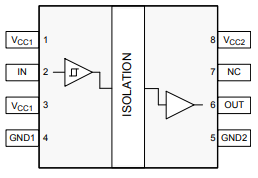Although they might sound similar, there are actually some noteworthy differences between isolated digital inputsand digital isolators. After reading this post, I hope it will be easy for you to tell the differences between the two isolation functions.
Internal structure
Digital isolators serve the basic (or often reinforced!) function of providing galvanic isolation digital signal paths. TI isolation structures are capacitive, with the insulation barrier consisting of two high-voltage capacitors built from our complementary metal-oxide semiconductor (CMOS) process technology. A high-frequency carrier communicates across the isolation barrier from the primary side to the secondary side, and our digital isolators are capable of withstanding up to 12.8 kV of applied surge voltage and 1.5 kV of working voltage without breaking down the double capacitive barrier. A key component of digital isolators is the isolation rating of basic or reinforced.
Figure 1: Digital Isolator
Isolated digital inputs serve the basic (yes, basic!) function of providing galvanic isolation from a sensor input or other input type to a logic output for a host controller interface. Unlike digital isolators, the input stage of an isolated digital input (shown in figure 2) includes a user-set input threshold and integrated current limit that allows input voltages ranging from 9V to 60V to be translated to a logic output. In its simplest form, isolated digital inputs operate as isolated comparators, with some great added features for ease of design.
Figure 2: Isolated Digital Input
Use differences
Digital isolators are typically used between analog-to-digital converters (ADCs) or data-acquisition converters and a host controller or microcontroller (MCU) in the signal path. Digital isolators are also commonly found in the isolated power-supply functions of a given system.
Isolated digital inputs are designed specifically as digital input receivers for programmable logic control (PLC), motor control and grid applications to interface between field-side inputs and a host controller. Isolated digital inputs are field-side facing inputs that are easily configurable for sinking and sourcing applications. An integrated current limit minimizes the thermal profile of the input in higher input-voltage environments and is set with a simple external resistor for compliance to International Electrotechnical Commission (IEC) 61131-2 switch types 1, 2 or 3. An additional resistor sets the input-voltage threshold; an online calculator is available to make resistor selection easy
Power differences
Digital isolatorsrequire both primary- and secondary-side power. In Figure 3, an isolated power supply powers the ADC and the “field side” of the digital isolator interfacing the ADC.
Figure 3: ISO7741 isolates MCU and ADC communication
Isolated digital inputs require secondary-side power only. In the ISO1211 (Figure 4) and the ISO1212 isolated digital inputs, the field side is powered from the input, so no field-side power is needed. This makes for a simpler design on the front end compared to alternative discrete solutions.
Figure 4: ISO1211 configured for PLC Digital Input Module
Our new isolated digital inputs are one example of some of the innovative ways that TI is making the world’s most robust and reliable isolation solutions easier and more efficient.
Additional resources
- How To Simplify Isolated 24-V PLC Digital Input Module Designs
- Space Saving Design Techniques for Multi-Channel High Voltage Digital Input Modules



